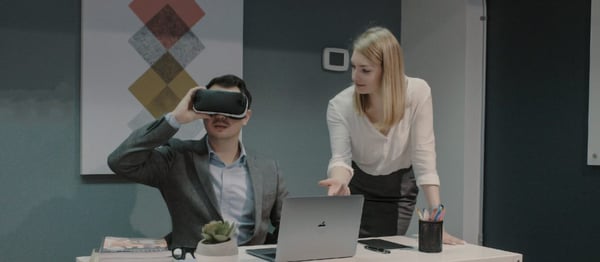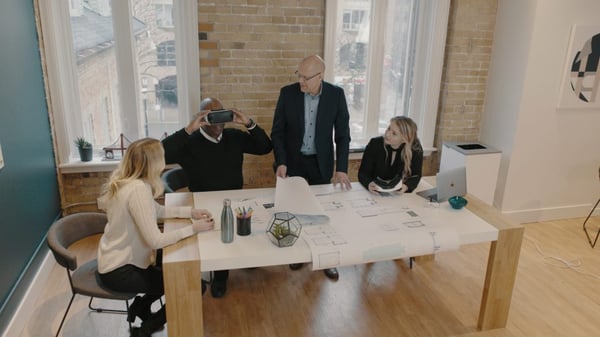Businesses of all size have been exploring practical use cases of virtual reality because they recognize the power of this new medium in sales, marketing, training and more. Walmart is currently the world’s largest company by revenue and is implementing the technology enhancing their skills development sector - not a bad endorsement for VR.
As other companies look to how they should be adopting VR, new implementations in training, architecture, interior designer, and engineering are using the tool as a step in their visual storytelling for sales and marketing.
VR Technology is Rapidly Evolving
A few years ago, the only VR headsets available were tethered and relied on external sensors to track movement. Although the headset produced a relatively high-quality VR experience, there were limitations to using the hardware as a practical business tool. The price to purchase the hardware, and have a powerful enough PC to run it was outside what most businesses were willing to spend on an unproven technology at the time, ranging from $1000-$2000 for the headset alone and a $5000 computer to run it.
.jpg?width=450&name=jens-kreuter-159303-unsplash-1-1024x762%20(1).jpg)
Besides the steep pricing, tethered headsets drastically limit a client or customer’s mobility. Not only are you limited in the range of movement by the wires and external sensors, but for safety reasons, you needed an employee nearby at all times while someone was using it. And because of the complexity of the computer running it and the sensors, it wasn’t at all practical to move the rig to a client's office, meaning they had to come to you. -
The evolution and hardware that has made VR in Sales and Marketing a practical possibility. Mobile standalone headsets allow users to experience VR free from any external wires and sensors, letting you take VR with you to immerse your clients with ease no matter where the meeting is held. Among our A&D clients, we hear that about 80% of meetings take place at the client’s office so mobility is critical.
.jpg?width=600&name=oculus-quest-1-1024x522%20(1).jpg)
Now, you may be thinking, “VR sounds really great, but it sounds like it’s made for just a handful of industries”.
This is not true.
Virtual Reality is a tool that fosters a perfect understanding between the presenter and the audience. This could mean a one-on-one basis and can certainly be from one department to another.
Let’s dive into how VR could enhance your marketing and sales department.
VR in Sales and Marketing
It seems that the two departments stereotypically don’t get along due to differences in methods and end goals. However, VR could be used as a bridge between the two worlds by encouraging opportunities to collaborate with one another.
1. Captivate your Audience’s Attention
Consumers are still quite fascinated by VR and the notion of being transported into another environment. The advanced tech has moved past merely being a fad and into being a legitimate tool that can be used to drive prospect clients and close the sale faster.
Marketing campaigns that utilize VR can attract new leads when VR experiences are part of a landing page, or an in-store event. Not only does this set your business apart by being tech-forward, but the technology itself appeals to customers on a visceral level.. Presenting the same product’s story in an immersive way by showing your clients rather than just telling them about it, and allowing them to see the product in context can earn trust. Incorporating VR into your strategy to encourage lead generation and trial prospects will support the sales team with interested potential clients.

A salesperson can also utilize this tool to engage with their clients as it gives them the opportunity to get as close to the product without it being physically there. Plus, with the latest in VR hardware, bring the experience to your clients with ease. The beauty of VR is that what you see is what you get. This allows you to showcase your products candidly so your client can understand what the product is exactly.
2. Interactivity = Good
One of the winning features of VR is the element of interaction.
It can be difficult making a presentation that is both informative and memorable. Utilizing VR in sales and marketing is one tactic that could help with attracting and retaining clients.
Research shows that seeing promotes a better memory recall than hearing information. Your brain when seeing a piece of information begins to instantly draw connections from other objects or life experiences you have encountered. Being able to draw connections stimulates the audience, making the experience more enjoyable, leaving a lasting impression. And studies indicate VR experiences activate different areas of the brain and drive even greater recall than 2D images, likely due to the greater comparisons to real-world objects.
Presentations can easily become boring, and you can lose your audience’s interest pretty quickly. However, hand your client a VR headset and let them be transported into a whole new way of viewing your products. Not only are you giving your clients the opportunity to interact with the presentation itself, but it also allows them to experience your product for themselves.

3. Connect Better, Connect Smarter
Many criticisms that arise from using VR is that it’s an experience that only one person gets to try out at one time. Although it is fair to say that one headset can only support one user at the time, this doesn’t have to make VR an isolating experience. Instead, it can be a group experience in the store and in showroom locations, generating positive feedback about combining experiences with purchasing. Syncing the headset to a screen allows other customers to see what the person in the headset is experiencing and drive people to want to try the experience.
You can also bring this community experience to sales presentations in a boardroom setting with features that allow you and others in the room to see what the headset wearer is seeing. As an example, our Yulio platform includes a Collaborate feature that allows the rest of the room to see what the viewer is looking at. As you continue to pass the headset around, give everyone else a sneak peek as to what they can look forward to when they wear the headset. Despite the limit of one user per headset, we figured out a way to combat the exclusivity so everyone can enjoy a part of VR. It’s also a critical element of your sales pitch for you to understand what your client is looking at when you receive feedback like “it feels too bright/big/small” etc.

It’s great having an element that can engage your audience, however, if you only have the one headset to pass around, be prepared to stall until everyone has had their turn. Not only could this quickly become a distraction, but it could also dilute the purpose of your presentation rather than enhance it. Our collaborate feature allows you to streamline your presentation by keeping the whole group informed until it’s their turn to interact with your product.
Enhance your Teams with VR
Ultimately, VR is a tool that promotes a perfect understanding and is able to take your sales and marketing teams to the next level. It’s time to welcome the new way of acquiring customers and retaining the relationships.
Here at Yulio, we strive for excellence in performance and integrity when it comes to our product, and customer service. If you’re interested in learning how to implement VR into your workflow, sign up for our FREE 5-day email course. Or check out our collection of whitepapers to discover all of our tips, tricks, and considerations for a successful VR implementation.



.jpg?width=245&height=150&name=active-adult-beautiful-1799244%20(1).jpg)


